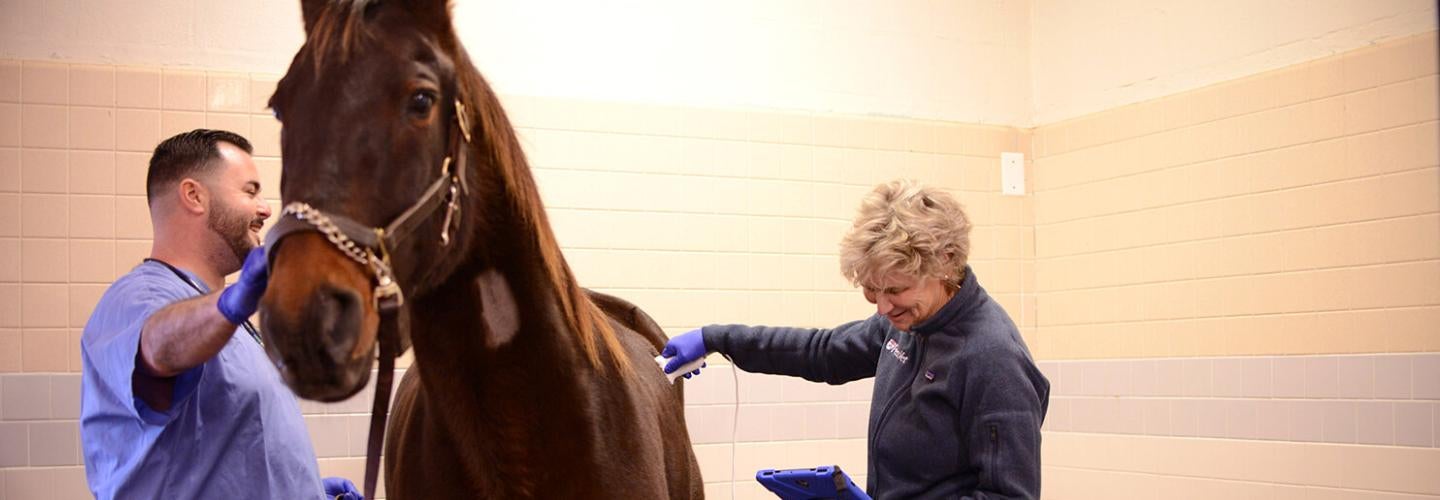
Emergency & Critical Care
What we do
New Bolton Center offers top-notch 24-hour emergency services to address any medical or surgical emergency; plus provide critical care for all domestic large animals.
Our emergency team includes dual-board-certified specialists and experienced, certified veterinary nurses, and care is provided in our state-of-the-art facilities.
Our Services
What to Expect from Our Care
Our Services
What to Expect from Our Care
What to Expect
When you are facing a medical emergency, it’s helpful to know what you might expect when you show up at New Bolton Center.
Here are some tips for what to do and what you can expect once you get here.
- First, call ahead at (610) 444-5800! A call from either you or your veterinarian to speak with the on-call veterinarian will allow us to be ready and waiting for you when you arrive at New Bolton Center.
- When you arrive, please call the office at 610-444-5800 as you are driving onto the New Bolton campus and into the trailer parking area. You can park in the trailer parking lot and follow signs to “Admissions”. Our front desk staff is available 24 hours a day, 7 days a week and will alert the doctors and nurses that you have arrived.
- The nature of your animal’s emergency will determine what happens next. Most often, a clinical care technician will assist you in unloading your animal from your vehicle and will lead your animal to an area where assessment and treatment can begin.
- New Bolton Center is a teaching hospital, so there might be several people attending to your animal, including a senior clinician, a resident and/or an intern, a senior veterinary student, nurses, and a nursing student.
- Your animal will receive a thorough assessment and appropriate emergency care at whatever time you arrive. The attending clinician will discuss the findings with you so that decisions regarding further diagnostic testing and care can be made. Following initial assessment, a cost estimate for care will be made and you will be asked to leave a deposit for treatment.
Common Emergencies
- Colic – an abdominal pain in the horse, covers numerous types of gastrointestinal distress. This painful condition in horses can come on suddenly, seemingly out of nowhere, and while the vast majority of horses recover, it is a leading cause of death in equines. Learn more about Colic below.
- Dealing with Lacerations and Cuts – any cut or laceration should be seen by your veterinarian. Even a small cut on the back of a fetlock could be serious if not treated immediately. Both the size and the location of the wound need to be considered and your local veterinarian can help you decide if your horse should be referred in for further treatment.
- Serious trauma – any animal that has sustained serious trauma should be seen immediately by either your local veterinarian or by a specialist at New Bolton Center. Serious underlying conditions can be initially masked by adrenaline and prompt veterinary care should always be sought.
- Fever and Coughing – there are dozens of reasons why your horse could be coughing.
- There are dozens of reasons why your horse could be coughing. A cough could be a mild irritation, or it could indicate an underlying condition that needs treatment. By paying close attention to when and where the cough occurs, as well as any additional clinical signs, you can help your veterinarian find the cause of the cough and the cure for your horse.
- The first thing to determine is whether your horse has a fever. Take your horse’s temperature. If the temperature is higher than 101.5 degrees Fahrenheit, contact your veterinarian. A cough with a fever may indicate an infection and warrants veterinary care immediately.
- Down Animals – if your horse or animal is experiencing periods of recumbency (lying down and being unable to rise), they should be examined by your veterinarian or brought to New Bolton Center. Even if your horse cannot get up, it is still possible to transport your horse to New Bolton Center for further evaluation and treatment. Our Field Service and local clients have the additional support of calling our equine ambulance for such needs.
James M. Moran, Jr. Critical Care Center
The James M. Moran, Jr. Critical Care Center provides round-the-clock veterinary care for large animals suffering from critical illness. The facility has a Neonatal Intensive Care Unit for at-risk pregnant mares, premature foals, and foals needing intensive care; as well as a designated bio-secure environment for animals suffering from infectious disease.
Features of the Center
- It is a single-story structure with two separate wings, one for isolation patients and one for colic patients.
- Both wings have their own procedure rooms, laundry rooms, and small antechambers that are used for sterilization.
- The building has an environmentally controlled air circulation system and pressurized central corridors.
- The building is also equipped with technical advances that will make care and monitoring of patients much more efficient and effective.
What Board Certification Means for your Animal’s Care
A specialist in large animal emergency critical care is a specially trained veterinarian dedicated to treating life-threatening conditions. Board certification requires extensive additional training, which strongly influences the veterinarian’s expertise in treating patients.
After receiving a veterinary degree (DVM or VMD), a large animal criticalist must:
- First complete a residency program in large animal surgery, medicine, or anesthesia. Following completion of a residency, board certification in the specialty is obtained by passing a comprehensive examination given by the specialty college (ACVS, ACVIM, or ACVAA).
- After completion of the residency, the prospective specialist will receive a minimum (or equivalent) of two to three additional years of intense training in emergency, surgery, and critical care through completion of an American College of Veterinary Emergency and Critical Care (ACVECC)-approved training program.
- Once the veterinarian has completed these years of specialty residency training, the individual must then pass a rigorous board-certification examination given by the ACVECC. Upon successful completion of the training and passing of the examination, the veterinarian is a Diplomate of the ACVECC, is termed a “specialist” in emergency critical care, or a “criticalist”, and is board-certified in veterinary emergency and critical care.
Our Care Team
Clinicians
Interns and Fellows

Anthony Cervone, DVM

Kayla Even, VMD

Arturo Fernández, DVM

Samuel Gonzalez, DVM

Kaylee Montney, DVM

Flavie Payette, DVM, DACVIM

Garett Pearson, DACVS

Hannah Quail, DVM

Bryana Smith, DVM
Christopher Rizzo, LVT, VTS
Dealing with Colic
Here are some general facts and tips on dealing with this condition.
Don’t Miss the Signs
- Feed – Goes off feed and shows little interest in grass
- Facial Distress – Curls lip, grinds teeth or shows other signs of mild distress
- Daily manure – Doesn’t pass manure in a normal time frame; passes hard, dry manure; has diarrhea
- Pawing and stretching – Paws the ground or stands stretched out with legs parked out in front and behind
- Checking, biting, kicking at pain – Repeatedly turns to look at flank; nips or kicks at belly
- Getting up and going down, rolling – Lies down and gets up, tries to roll, sits on haunches like a dog
- Violent rolling – Persistent rolling, which can be violent
Types of Colic
Discomfort brought on by excess gas in any part of the intestines. This is one of the most common forms of colic and the outlook for recovery with medical management is generally good.
Inflammation in the section of the small intestine closest to the stomach. The cause isn’t always clear. The small intestine stops working and becomes distended with fluid that backs up into the stomach. This is usually treated medically.
Typically develop when an accumulation of undigested feed blocks the flow through the intestinal tract. Most impactions can be treated medically, but severe ones may require surgery.
These occur in the last section of the small intestine, near the cecum. Two factors seem to be associated with blockage here – infestation with tapeworms and ingestion of coastal Bermuda grass hay, which is widely fed in the Southeast.
Develops when a horse takes in particles of sand or grit during grazing or while eating feed. The sand settles in the intestines, and over time it can irritate the intestinal linking or it may build up to create a blockage (sand impaction).
Intestinal stones that form when minerals build up around something indigestible that the horse consumes. A single stone or multiple stones can form and may block the intestine. These are treated surgically.
Occurs when the large colon moves out of place. This type of event is fairly common because the majority of a horse’s large colon can move freely in the abdomen.
Occurs when the large colon twists on itself. This event is life threatening because the twist causes strangulation (cutting off the blood supply to) the affected section, and it requires immediate surgery.
This condition can develop in several ways. Older horses can develop fatty masses that can wrap around the small intestine and cut off the blood supply. Or a section of the small intestine may get trapped in a space between different organs in the abdomen (such as the liver and pancreas). Or a section of intestine can telescope into itself, causing an intussusception. Regardless of the specific cause of the strangulation, the result in all of these cases is a cutting off of the blood supply to the intestine, which requires surgical correction.
Fellowship in Large Animal Emergency and Critical Care
The Department of Clinical Studies – New Bolton Center, University of Pennsylvania School of Veterinary Medicine, is seeking applicants for a fellowship position in Large Animal Emergency and Critical Care (ECC). Candidates must have a DVM/VMD or equivalent and previous residency training in surgery, internal medicine, or anesthesia, as well as be board-eligible or board-certified in their respective discipline at the time they begin fellowship training.
The fellowship program is a 2-year clinical program starting July 2026 in accordance with fellowship training requirements in the American College of Veterinary Emergency and Critical Care (ACVECC). The program consists of large animal ECC immersion in addition to training within other services, including elective surgery, internal medicine, cardiology, ophthalmology, diagnostic imaging, neurology, and anesthesia. The position requires after-hours and emergency on-call clinical duty at New Bolton Center. The fellow will participate in clinical teaching of students, rounds, and seminar presentations to peer groups. With faculty guidance, the fellow will also participate in a research project of their choice.
The successful candidate will join a team of critical-care specialists who are enthusiastic about advancing the highest quality emergency care for large animal patients, the education of future veterinarians and veterinary specialists, and the expansion of scientific knowledge. Dedicated medicine and surgery residents, rotating interns, support staff, and clinical-year students round out the team. The New Bolton Center Hospital enjoys a large and diverse caseload consisting of over 7000 cases per year, of which > 1200 are emergency admissions of equine and farm-animal patients. New Bolton Center is located southwest of Philadelphia in bucolic horse country with easy access to a variety of cultural and social activities in the MidAtlantic region. We are seeking a candidate who enjoys an intellectually stimulating environment and shares our values of integrity, leadership, respect, accountability, and passion to join our team.
Application materials should include 1) curriculum vitae, 2) letter of intent indicating professional interests and career goals, 3) transcript of university performance, including documentation of graduation, and 4) three letters of recommendation. Applications will be considered until the position is filled.
Submit application materials to: Patricia Antes,Assistant to the Chair, Department of Clinical Studies – New Bolton Center at antes@vet.upenn.edu.
Inquiries about the program can be directed to Dr. Maia Aitken, ECC Fellowship Program Director – 607-857-1079, maitken@vet.upenn.edu
The successful applicant will be required to sign a non-disclosure and non-competition agreement prior to the start of the program.
The University of Pennsylvania is an equal opportunity employer. Candidates are considered for employment without regard to race, color, sex, sexual orientation, religion, creed, national origin (including shared ancestry or ethnic characteristics), citizenship status, age, disability, veteran status or any class protected under applicable federal, state, or local law.





